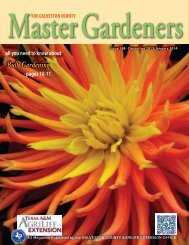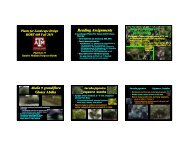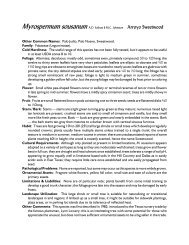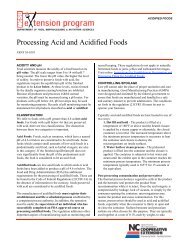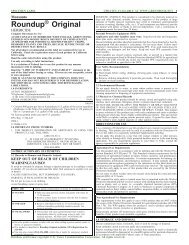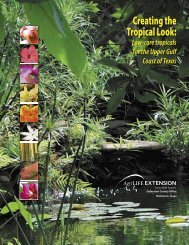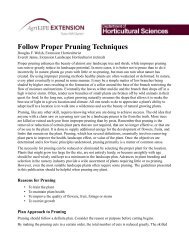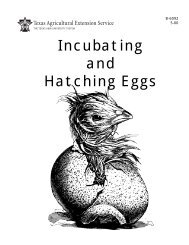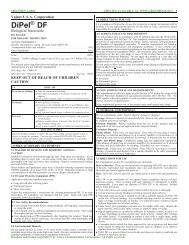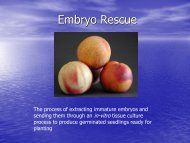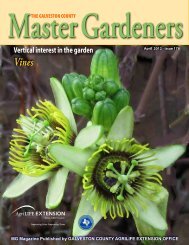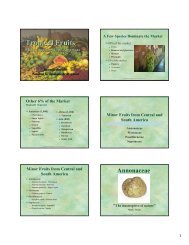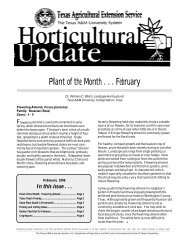EXAM III HORT 326 April 21, 2005 Indicate the ... - Aggie Horticulture
EXAM III HORT 326 April 21, 2005 Indicate the ... - Aggie Horticulture
EXAM III HORT 326 April 21, 2005 Indicate the ... - Aggie Horticulture
Create successful ePaper yourself
Turn your PDF publications into a flip-book with our unique Google optimized e-Paper software.
<strong>EXAM</strong> <strong>III</strong><strong>HORT</strong> <strong>326</strong><strong>April</strong> <strong>21</strong>, <strong>2005</strong><strong>Indicate</strong> <strong>the</strong> most correct answer in <strong>the</strong> left-hand column (44 pts @ 2 pts/question).____1.____ 2.Seedling rootstock:a. generally produce a larger tree than a clonal semi-dwarfing rootstockb. is more commonly used with apples and pears in <strong>the</strong> U.S. than clonal rootstockc. is generally more expensive to produce than clonally-produced rootstockd. a, b & ce. a & cIn certain budding and grafting systems it is necessary to have <strong>the</strong> bark “slip”; this is controlled by:a. adequate auxin levelsb. an active vascular cambiumc. optimal soil and plant water statusd. a, b & ce. a & b____ 3.The absolute size of a grafted plant is determined by:a. <strong>the</strong> rootstock effect on <strong>the</strong> scionb. <strong>the</strong> scion effect on <strong>the</strong> rootstockc. soil conditions, temperature, and fertilization practicesd. a, b & ce. a & b_____4. The following graft(s) may be done in apical graftage:a. whip and splice graftb. bridge graftc. spliced approach graftd. a, b & ce. a & b_____5. Which potential grafting/budding system is most commonly used for topworking a commercial pecanorchard of larger caliper trees in Texas:a. whip graftb. banana (4-flap) graftc. patch buddingd. inlay bark grafte. chip budding_____6. Shimomura in his grafting research with cactus:a. applied growth regulators as a spray applicationb. found that auxins stimulated <strong>the</strong> grafting processc. found that growth regulators applied in high concentrations stimulated <strong>the</strong> grafting processd. a & be. b & c_____7. For grafting purposes, <strong>the</strong> “wood” is generally composed ofa. cortex and xylemb. xylem and pithc. cortex, phloem, vascular cambium and peridermd. vascular cambium, phloem, xylem, periderm and pi<strong>the</strong>. xylem and vascular cambium
2____8.Some reasons why layering can enhance rooting compared to conventional cutting propagationunder mist include:a. higher levels of auxins and rooting cofactorsb. lower percentage of parenchyma cells, compared to sclereids and fibersc. higher levels of ABA and GAd. a, b & ce. a & b____9.Types of "repair grafting" for weak rootstocks or injured trunks, or weak crotch angles are:a. inlay bark graft and saddle graftb. bridge grafting and inarchingc. saddle graft and 4-flap graftd. a, b & ce. b & c____10. During graft union formation in <strong>the</strong> callus bridge:a. wound xylem is formed initially from auxin, which diffuses down from <strong>the</strong> scionb. wound phloem is initially formed from auxin and carbohydrates, which diffusedown from <strong>the</strong> scionc. fur<strong>the</strong>r xylem and phloem development occurs from a new cambium layer that isformed in <strong>the</strong> callus bridged. a, b & ce. a & b____11. Nurse root grafting:a. can be done by girdling <strong>the</strong> nurse root rootstock below <strong>the</strong> graft union.b. used in rooting difficult-to-root rootstockc. commonly done with serpentine layering to encourage <strong>the</strong> scion to form rootsd. a, b, and ce. a & b____12. In root grafting, <strong>the</strong> normal polarity is:a. proximal of rootstock to proximal of scionb. distal of rootstock to proximal of scionc. proximal of rootstock to distal of sciond. distal of rootstock to distal of scion____13. Which potential grafting/budding system would most likely be used in a Mississippi pecan nursery:a. banana (4-flap) graftb. whip-and-tongue graftc. inlay bark graftd. patch buddinge. chip budding___14.In <strong>the</strong> Malling-Merton series of clonal apple rootstock:a. dwarfing clonal rootstock are sometimes used as an interstockb. semi-dwarfing understocks are about half <strong>the</strong> size of seedling understocksc. very vigorous understocks can produce a tree as large as a seedling rootstockproduced treed. a, b & ce. b & c
3____15. The following layering system generally is not covered with a mineral, field soil during <strong>the</strong> layeringprocess.a. mound (stool) layeringb. trench layeringc. tip layeringd. air layeringe. serpentine layering____16. Incompatibility in <strong>the</strong> Bartlett pear was:a. prevented when a Old Home Pear interstock was usedb. an example of translocatable incompatibilityc. caused by <strong>the</strong> conversion (breakdown) of prunasin to free H 2 SO 4 and HCld. a, b & ce. a & c____17. When compared to vigorous, seedling rootstock, dwarfing rootstock generally have:a. higher ABA levelsb. lower xylem sap flowc. lower starch and/or carbohydrate accumulationd. a, b & ce. a & b____18. What is not true of <strong>the</strong> Texas rose bush industry:a. digging of two year rose bushes is done from late fall to early winter when plants are dormantb. a producer can potentially have 3 different generations planted in <strong>the</strong> field at <strong>the</strong> same timec. Rosa multiflora is <strong>the</strong> principal rootstock used and is thornlessd. it is common practice in Texas not to irrigate <strong>the</strong> rose crop during productione. sticking/propagation of hardwood cuttings is done in early spring & T-budding is done in August____19. Which potential grafting/budding system would most likely be used in a Texas pecan nursery:a. banana (4-flap) graftb. whip-and-tongue graftc. inlay bark graftd. patch buddinge. chip budding____20. In <strong>the</strong> following layering system, <strong>the</strong>re is a compression of <strong>the</strong> shoot apex in <strong>the</strong> soil that generallyleads to rooting in internodal areas behind <strong>the</strong> apex:a. serpentine layeringb. trench layeringc. tip layeringd. mound (stool) layeringe. air layering____ <strong>21</strong>. The following graft is commonly done with commercial vegetable crops:a. whip and tongue graftb. bridge graftc. inlay approach graftd. saddle grafte. splice graft____ 22.The following layering system requires that stock plant material be severely cut back (pruned):a. serpentine layeringb. tip layeringc. mounding (stool) layeringd. trench layeringe. air layering
4Circle <strong>the</strong> most correct answer in <strong>the</strong> following true-false statements. If <strong>the</strong> answer is false indicate why.(32 pts @ 2 pts/question).T F 23. One feature about grafting that is generally not found in budding is <strong>the</strong> use of an insurance bud.T. F. 24. The grafting terms rootstock, understock and interstock are synonymous.T F 25.T F 26.Almond and apricot can be grafted on a peach understock, but cannot be reciprocally grafted ontoeach o<strong>the</strong>r.The two most important budding systems for woody ornamental plants in <strong>the</strong> US are patch buddingand T-budding.T F 27. Advantages of seedling rootstocks include <strong>the</strong>ir ease of propagation, and generally lower diseaseproblems than clonally produced rootstock.T F 28. In summer budding a one-year scion and two-year rootstock is produced.T F 29. In approach grafting two independent, self-sustaining plants are grafted toge<strong>the</strong>r.T F 30. June budding is <strong>the</strong> preferred time to bud peaches in Tennessee or California nurseries [but not inTexas] with <strong>the</strong>ir long growing seasons; <strong>the</strong> budwood does not require storage since it is taken fromcurrent season's wood.T F 31. Summer budding is generally done from August through September in <strong>the</strong> U.S. ⎯ using winterharvestedbud wood (scions) maintained in cold storage.T F 32. Secondary growth allows for natural root/grafting to occur which are potential problems for <strong>the</strong>spread of Dutch elm disease and oak wilt.T F 33. Mound layering and hedging-back are techniques to keep stock plants in a rejuvenated condition(despite <strong>the</strong>ir chronological age); this enhances rooting.T F 34. The purpose of deeying Rosa multiflora cuttings is to break apical dominance of <strong>the</strong> rootstock.T F 35. Natural layering of plants can occur with <strong>the</strong> formation of runners, stolons, offsets and crowns.T F 36. Bark slips because <strong>the</strong> cortex and xylem starts to actively divide.T F 37.Banana plants will naturally layer; <strong>the</strong>y were initially transported from Polynesia to<strong>the</strong> West Indies by <strong>the</strong> British and were <strong>the</strong> catalyst for <strong>the</strong> mutiny of <strong>the</strong> crew of <strong>the</strong>HMS Bounty.T F 38. In citrus, <strong>the</strong> virus tristeza can be a contributing factor to pathogen-induced incompatibility.
(6 pts)539. Grafting has been around since <strong>the</strong> beginning of civilization when humankind first started to cultivatecrops. List and discuss four advantages and two disadvantages of grafting.40. Match <strong>the</strong> correct term with <strong>the</strong> following twenty definitions. There should be only oneterm per definition and not all terms have definitions. (18 pts @ 1 pt/definition)adhesionapical graftagebench grafting/bench workingbracingcallus bridgechip buddingcrowndrop layeringframeworkinginlay approach graftmicrobuddingnurse root graftingParafilm taperootstockroot graftageside stub graftstentingT-buddingwound peridermair layeringapproach graftagebridge graftbuddingcellular recognitioncompound layeringdouble workingfour-flap graftinarchingJune buddingmound layeringoffsetRaffiarunnerserpentine layeringside-veneer graftstolontopworkingwound-repair xylem and phloem
6________________________________________________________________________________________________________________________________________________________________________________________________________________________________________________________________________________________________________________________________________________________________________________________________________________A form of grafting which normally includes just one axillary budon <strong>the</strong> rootstock.The proliferation of callus cells at <strong>the</strong> graft interface.It may play an important role in graft compatibility/incompatibility.When you graft or bud twice; can obtain <strong>the</strong> benefits of certain interstocks.A temporary graft system to allow a difficult-to-root rootstock toform adventitious roots when it is a temporary scion piece.It allows a producer to switch out fruit cultivars in an existingorchard under production.The callus tissue formed from uninjured, rapidly dividingparenchyma cells (adjacent and internal to <strong>the</strong> necrotic layer).When two independent, self-sustaining plants are grafted toge<strong>the</strong>r.Used to streng<strong>the</strong>n scaffolding limbs of a tree in order to bettersupport <strong>the</strong> weight of <strong>the</strong> fruit crop.In this process grafts/budding is made high in <strong>the</strong> tree in <strong>the</strong> smallsecondary scaffold branches.A type of grafting used to replace a weak rootstock system.Strips of this palm leaf stalk fiber are used to wrap grafts.The simultaneous rooting and grafting of rose understock.It is sometimes referred to as shield budding.Also referred to a pot layerage, cirucumposition, marcottage and gootee.Generally done with both a dormant rootstock and dormant scion.In herbaceous perennials it is <strong>the</strong> part of <strong>the</strong> plant where <strong>the</strong> newshrubs annually arise.A lateral shoot or branch that develops from <strong>the</strong> base of <strong>the</strong> mainstem, i.e., slips and suckers in pineapples.



